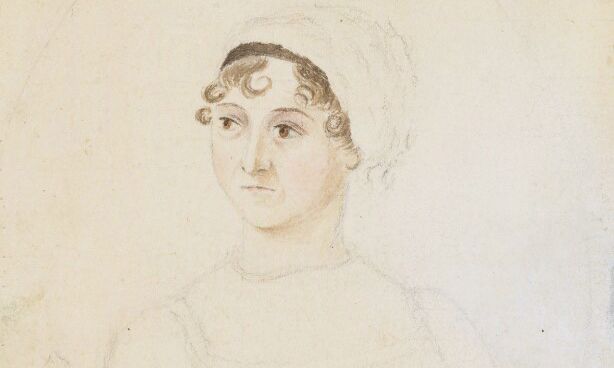Portrait of Jane Austen by her sister Cassandra (around 1810). An image based on the drawing now appears on £10 notes © National Portrait Gallery, London
If you remember precisely what a character in a Jane Austen novel wears, including Mr Darcy’s wet shirt, it is almost certainly a false memory taken from a film or television adaptation. Austen rarely provides sartorial detail in her fiction, yet clothes are immensely important as indicators of status as well as character—particularly in a world in which so many of her people, from half-pay officers to excess daughters, widows and gallantly sociable spinsters, are keeping up appearances on slightly less money than the job requires.
In Austen’s books—from Sense and Sensibility (first published in 1811) to Persuasion and Northanger Abbey (published together posthumously in December 1817)—she implies rather than describes. In Pride and Prejudice (first published in 1813), Elizabeth Bennett’s aunt, Mrs Gardiner, is “elegant”, despite being married to a man living “within view of his own warehouses”—a professional man in trade, rather than a member of the leisured gentry. You know that she is up to the mark, but not over it. In striking contrast, when the appalling Mr Collins reassures Elizabeth that she need not panic before an evening visit to the atrocious Lady Catherine de Bourgh—since “Lady Catherine will not think the worse of you for being simply dressed. She likes to have the distinction of rank preserved”—you know that although one is an Anglican clergyman and the other an aristocrat, unlike Elizabeth neither is truly well bred.
When the farthings and half pennies really matter, a proper, but not excessive, attention to dress is admirable. A famous passage in Northanger Abbey illuminates the character of the hero Mr Tilney, revealed as witty and a thoroughly good egg, despite being a younger son and a clergyman, when he is asked in astonishment if he really knows about muslin: “‘Particularly well; I always buy my own cravats, and am allowed to be an excellent judge; and my sister has often trusted me in the choice of a gown. I bought one for her the other day, and it was pronounced to be a prodigious bargain by every lady who saw it. I gave but five shillings a yard for it, and a true Indian muslin.’ Mrs. Allen was quite struck by his genius.”
The price of muslin and cambric, warming flannel or mourning bombazine is thoroughly discussed by fashion historian Hilary Davidson in this charming book, which examines what Austen actually wore on the evidence of voluminous letters exchanged with her sister Cassandra whenever they were separated. The record is incomplete, since, to the anguish of every Austen biographer, Cassandra destroyed hundreds, possibly thousands of letters before her death in 1845.
Cassandra is also the source of the only verifiable images of Jane in life: a back view of a figure in blue; and a sweet, amateurish portrait (around 1810) of a young woman in a high-waisted dress. With a historian’s eye, Davidson notes that the back fastening in the former was a brand new fashion in 1804, and that the increasingly prettified versions of the later portrait, which ended up on English £10 bank notes, introduced anachronistic later sleeve details.
The sisters chat about bonnets to be rejuvenated with new ribbon, laundry disasters, sensible brown for morning chores, dainty white muslin dresses for summer holidays or daring new designs from fashion journals that could conceivably be copied by village dressmakers. Lavish illustrations accompany the garments and accessories, from ball gowns to shifts by way of handkerchiefs, jewellery and silk bonnets decorated with artificial greengages—“flowers are very much worn & Fruit is still more the thing”, wrote Jane Austen from Bath in 1799—with photographs of surviving originals from museum collections, including those owned by the novelist, along with contemporary portraits and fashion plates. This is not, perhaps, an essential addition to the vast canon of books about Austen, but it is a delightful companion on a wet afternoon—and the Janeites, preparing to tie their bonnet strings to parade through the streets of Chawton or Bath, will adore it.
• Hilary Davidson, Jane Austen’s Wardrobe, Yale, 240pp, 200 colour & b/w illustrations, £25 (hb), published 12 September
• Maev Kennedy is a freelance arts and archaeology journalist and a regular contributor to The Art Newspaper

